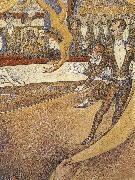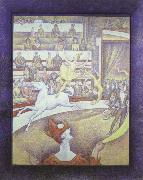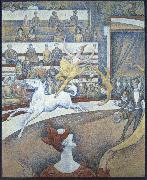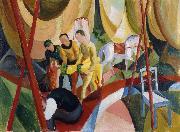Wholesale Oil Painting Reproductions No Minimum and Door to Door! |
|||||||||||
|
|
|||||||||||

|
|||||||||||
|
|
|
||||||||
All Georges Seurat Oil Paintings |
||||||||
|
|
||||||||
|
|
||||||||
|
Artist Introduction: French Pointillist Painter, 1859-1891
Georges-Pierre Seurat (2 December 1859 ?C 29 March 1891) was a French painter and draftsman. His large work Sunday Afternoon on the Island of La Grande Jatte, his most famous painting, altered the direction of modern art by initiating Neo-impressionism, and is one of the icons of 19th century painting
Seurat took to heart the color theorists' notion of a scientific approach to painting. Seurat believed that a painter could use color to create harmony and emotion in art in the same way that a musician uses counterpoint and variation to create harmony in music. Seurat theorized that the scientific application of color was like any other natural law, and he was driven to prove this conjecture. He thought that the knowledge of perception and optical laws could be used to create a new language of art based on its own set of heuristics and he set out to show this language using lines, color intensity and color schema. Seurat called this language Chromoluminarism.
His letter to Maurice Beaubourg in 1890 captures his feelings about the scientific approach to emotion and harmony. He says "Art is Harmony. Harmony is the analogy of the contrary and of similar elements of tone, of color and of line, considered according to their dominance and under the influence of light, in gay, calm or sad combinations".
Seurat's theories can be summarized as follows: The emotion of gaiety can be achieved by the domination of luminous hues, by the predominance of warm colors, and by the use of lines directed upward. Calm is achieved through an equivalence/balance of the use of the light and the dark, by the balance of warm and cold colors, and by lines that are horizontal. Sadness is achieved by using dark and cold colors and by lines pointing downwards. |
||||||||
|
|
||||||||
|
Circus Painting ID:: 35864 |
mk106
1890-1891
185x150cm
|
|||||||
Height Width |
INS/CM Quality |
|||||||
|
X |
| |||||||
|
|
||||||||
All Georges Seurat Oil Paintings |
||||||||
|
|
||||||||
|
|
||||||||
|
Artist Introduction: French Pointillist Painter, 1859-1891
Georges-Pierre Seurat (2 December 1859 ?C 29 March 1891) was a French painter and draftsman. His large work Sunday Afternoon on the Island of La Grande Jatte, his most famous painting, altered the direction of modern art by initiating Neo-impressionism, and is one of the icons of 19th century painting
Seurat took to heart the color theorists' notion of a scientific approach to painting. Seurat believed that a painter could use color to create harmony and emotion in art in the same way that a musician uses counterpoint and variation to create harmony in music. Seurat theorized that the scientific application of color was like any other natural law, and he was driven to prove this conjecture. He thought that the knowledge of perception and optical laws could be used to create a new language of art based on its own set of heuristics and he set out to show this language using lines, color intensity and color schema. Seurat called this language Chromoluminarism.
His letter to Maurice Beaubourg in 1890 captures his feelings about the scientific approach to emotion and harmony. He says "Art is Harmony. Harmony is the analogy of the contrary and of similar elements of tone, of color and of line, considered according to their dominance and under the influence of light, in gay, calm or sad combinations".
Seurat's theories can be summarized as follows: The emotion of gaiety can be achieved by the domination of luminous hues, by the predominance of warm colors, and by the use of lines directed upward. Calm is achieved through an equivalence/balance of the use of the light and the dark, by the balance of warm and cold colors, and by lines that are horizontal. Sadness is achieved by using dark and cold colors and by lines pointing downwards. |
||||||||
|
|
||||||||
|
|
circus Painting ID:: 56347 |
mk247
1891,oil on canvas,73x59.875 in,185.5x152 cm,musee d orsay,paris,france |
||||||
Height Width |
INS/CM Quality |
|||||||
|
X |
| |||||||
|
|
||||||||
All Georges Seurat Oil Paintings |
||||||||
|
|
||||||||
|
|
||||||||
|
Artist Introduction: French Pointillist Painter, 1859-1891
Georges-Pierre Seurat (2 December 1859 ?C 29 March 1891) was a French painter and draftsman. His large work Sunday Afternoon on the Island of La Grande Jatte, his most famous painting, altered the direction of modern art by initiating Neo-impressionism, and is one of the icons of 19th century painting
Seurat took to heart the color theorists' notion of a scientific approach to painting. Seurat believed that a painter could use color to create harmony and emotion in art in the same way that a musician uses counterpoint and variation to create harmony in music. Seurat theorized that the scientific application of color was like any other natural law, and he was driven to prove this conjecture. He thought that the knowledge of perception and optical laws could be used to create a new language of art based on its own set of heuristics and he set out to show this language using lines, color intensity and color schema. Seurat called this language Chromoluminarism.
His letter to Maurice Beaubourg in 1890 captures his feelings about the scientific approach to emotion and harmony. He says "Art is Harmony. Harmony is the analogy of the contrary and of similar elements of tone, of color and of line, considered according to their dominance and under the influence of light, in gay, calm or sad combinations".
Seurat's theories can be summarized as follows: The emotion of gaiety can be achieved by the domination of luminous hues, by the predominance of warm colors, and by the use of lines directed upward. Calm is achieved through an equivalence/balance of the use of the light and the dark, by the balance of warm and cold colors, and by lines that are horizontal. Sadness is achieved by using dark and cold colors and by lines pointing downwards. |
||||||||
|
|
||||||||
|
|
circus Painting ID:: 71175 |
mk290 1890-91 canvsa 73x59in musee d orsay paris |
||||||
Height Width |
INS/CM Quality |
|||||||
|
X |
| |||||||
|
|
||||||||
All August Macke Oil Paintings |
||||||||
|
|
||||||||
|
|
||||||||
|
Artist Introduction: 1887-1914
August Macke Locations
August Macke was born in Meschede, Germany. His father, August Friedrich Hermann Macke (1845-1904), was a building contractor and his mother, Maria Florentine, n??e Adolph, (1848-1922), came from a farming family in Germany's Sauerland region. The family lived at Br??sseler Straße until August was 13. He then lived most of his creative life in Bonn, with the exception of a few periods spent at Lake Thun in Switzerland and various trips to Paris, Italy, Holland and Tunisia. In Paris, where he traveled for the first time in 1907, Macke saw the work of the Impressionists, and shortly after he went to Berlin and spent a few months in Lovis Corinth's studio. His style was formed within the mode of French Impressionism and Post-impressionism and later went through a Fauve period. In 1909 he married Elizabeth Gerhardt. In 1910, through his friendship with Franz Marc, Macke met Kandinsky and for a while shared the non-objective aesthetic and the mystical and symbolic interests of Der Blaue Reiter.
Macke's meeting with Robert Delaunay in Paris in 1912 was to be a sort of revelation for him. Delaunay's chromatic Cubism, which Apollinaire had called Orphism, influenced Macke's art from that point onwards. His Shops Windows can be considered a personal interpretation of Delaunay's Windows, combined with the simultaneity of images found in Italian Futurism. The exotic atmosphere of Tunisia, where Macke traveled in 1914 with Paul Klee and Louis Moilliet was fundamental for the creation of the luminist approach of his final period, during which he produced a series of works now considered masterpieces. August Macke's oeuvre can be considered as Expressionism, (the movement that flourished in Germany between 1905 and 1925) and also his work was part of Fauvism. The paintings concentrate primarily on expressing emotion, his style of work represents feelings and moods rather than reproducing objective reality, usually distorting colour and form.
Macke's career was cut short by his early death at the front in Champagne in September 1914, the second month of World War I. His final painting, Farewell, depicts the mood of gloom that settled after the outbreak of war.
|
||||||||
|
|
||||||||
|
|
Circus Painting ID:: 98227 |
1913(1913)
Medium oil on cardboard
Dimensions 47 x 63.5 cm
cyf |
||||||
Height Width |
INS/CM Quality |
|||||||
|
X |
| |||||||
|
|
||||||||
|
Prev Next
|
||||||||
|
|
||||||||
|
Related Paintings to August Macke :. |
||||||||
|
|
||||||||
|
CONTACT US |




